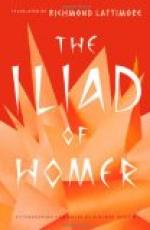10. [Or collar-bone.]
11. The belief of those times, in regard to the
peace and happiness of
the soul after death, made the protection
of the body a matter of
great importance. For a full
account of these rites, see the
articles Charon and Pluto, Gr. &
Rom. Mythology.
12. The physician of the gods. Homer says
nothing of his origin. He
seems to be considered as distinct
from Apollo, though perhaps
originally identical with him.
13. From the fact that so few mystical myths
are introduced in the
Iliad, Mueller infers that the mystical
element of religion could
not have predominated among the
Grecian people for whom Homer sang.
Otherwise, his poems in which that
element is but little regarded,
would not have afforded universal
pleasure and satisfaction. He
therefore takes but a passing notice
of Demeter. Mueller also
remarks, that in this we cannot
but admire the artistic skill of
Homer, and the feeling for what
is right and fitting that was
innate with the Greeks.
14. [Vide Samson to Harapha in the Agonistes.
There the word is used
in the same sense.—TR.]
15. [This is a construction of {leuk elephanti} given
by some of the
best commentators, and that seems
the most probable.—TR.]
16. This slow and orderly retreat of the Greeks,
with their front
constantly turned to the enemy,
is a fine encomium on their courage
and discipline. This manner
of retreating was customary among the
Lacedaemonians, as were many other
martial customs described by
Homer. The practice arose from
the apprehension of being killed by
a wound in the back, which was not
only punished with infamy, but a
person bearing the mark was denied
the rites of burial.
17. [This, according to Porphyrius as quoted by Clarke,
is the true
meaning of {aiolomitres}.—TR.]
18. The chariots of the gods were formed of various
metals, and drawn
through the air, or upon the surface
of the sea, by horses of
celestial breed. These chariots
were used by the deities only on
occasion of a long journey, or when
they wished to appear with
state and magnificence. Ordinarily
they were transported from place
to place by the aid of their golden
sandals, with the exception of
the “silver-footed Thetis,”
to whom they seem to have been
superfluous. When at home,
the gods were barefoot, according to the
custom of the age, as we see from
various representations of
antique art.
19. [These which I have called crescents, were a kind
of hook of a
semicircular form, to which the
reins were occasionally
fastened.—TR.]
20. The Greeks borrowed the vest and shield of
Minerva from the
Lybians, only with this difference:
the Lybian shield was fringed
with thongs of leather, and the
Grecian with serpents.—HERODOTUS.




